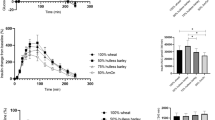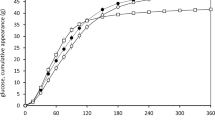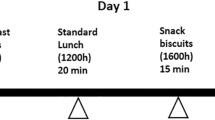Abstract
Objective:
To investigate if the improved glucose tolerance previously observed at breakfast following an evening meal with boiled barley kernels derives from colonic events related to the fermentation of the elevated amounts of indigestible carbohydrates present and/or from the low-GI features.
Subjects/Methods:
Twenty healthy volunteers aged 19–30 years.
Design:
High-GI white wheat bread (WWB), WWB+barley dietary fibre (DF) corresponding to the DF content of barley kernels, low-GI spaghetti+ barley DF, spaghetti+double amounts of barley DF (2*DF), spaghetti+oat DF, or whole grain barley flour porridge, were provided as late evening meals. At a subsequent standardised WWB breakfast, B-glucose, s-insulin, p-SCFA, p-FFA, and breath hydrogen (H2) were measured.
Results: The B-glucose response (incremental areas under the curves (IAUC) 0–120 min and total areas under the curves 0–180 min) to the standardized breakfast was significantly lower after consuming spaghetti+2*DF in the evening compared with barley porridge (P=0.012). The spaghetti+2*DF meal also resulted in the highest breath H2 excretion (P<0.02). The glucose IAUC (0–120 min) after the standardized breakfast was positively correlated to fasting p-FFA (r=0.29, P<0.02), and the total glucose area (0–180 min) was negatively correlated to the p-propionate level (0–30 min) (r=−0.24, P<0.02).
Conclusions:
The prolonged digestive and absorptive phase per se, like with a low-glycaemic index (GI) spaghetti evening meal, did not induce overnight benefits on glucose tolerance. Addition of barley DF in high amounts (2*DF) was required to improve overnight glucose tolerance. The correlations observed between glycaemia and p-propionate implicate colonic fermentation as a modulator of glucose tolerance through a mechanism leading to suppressed free fatty acids levels. It is proposed that the overnight benefits on glucose tolerance previously reported for boiled barley kernels is mediated through colonic fermentation of the prebiotic carbohydrates present in this product.
This is a preview of subscription content, access via your institution
Access options
Subscribe to this journal
Receive 12 print issues and online access
$259.00 per year
only $21.58 per issue
Buy this article
- Purchase on Springer Link
- Instant access to full article PDF
Prices may be subject to local taxes which are calculated during checkout



Similar content being viewed by others

References
Åkerberg AKE, Liljeberg HGM, Granfeldt YE, Drews A, Björck IM (1998). An in vitro method, based on chewing, to predict resistant starch content in foods allows parallel determination of potentially available starch and dietary fibre. J Nutr 128, 651–659.
Anderson JW, Bridges SR (1984). Short-chain fatty acid fermentation products of plant fiber affect glucose metabolism of isolated rat hepatocytes. Proc Soc Exp Biol Med 177, 372–376.
Anderson JW, Hanna TJ, Peng X, Kryscio RJ (2000). Whole grain foods and heart disease risk. J Am Coll Nutr 19, 291S–299S.
Asp N-G, Johansson C-G, Hallmer H, Siljeström M (1983). Rapid enzymatic assay of insoluble and soluble dietary fibre. J Agric Food Chem 31, 476–482.
Berggren AM, Nyman EM, Lundquist I, Bjorck IM (1996). Influence of orally and rectally administered propionate on cholesterol and glucose metabolism in obese rats. Br J Nutr 76, 287–294.
Boillot J, Alamowitch C, Berger AM, Luo J, Bruzzo F, Bornet FR et al. (1995). Effects of dietary propionate on hepatic glucose production, whole-body glucose utilization, carbohydrate and lipid metabolism in normal rats. Br J Nutr 73, 241–251.
Brand-Miller JC (2003). Glycemic load and chronic disease. Nutr Rev 61, S49–55.
Brighenti F, Benini L, Del Rio D, Casiraghi C, Pellegrini N, Scazzina F et al. (2006). Colonic fermentation of indigestible carbohydrates contributes to the second-meal effect. Am J Clin Nutr 83, 817–822.
Evans JL, Goldfine ID, Maddux BA, Grodsky GM (2003). Are oxidative stress-activated signaling pathways mediators of insulin resistance and beta-cell dysfunction? Diabetes 52, 1–8.
Ferrannini E, Barrett EJ, Bevilacqua S, DeFronzo RA (1983). Effect of fatty acids on glucose production and utilization in man. J Clin Invest 72, 1737–1747.
Fontvieille AM, Rizkalla SW, Penfornis A, Acosta M, Bornet FR, Slama G (1992). The use of low glycaemic index foods improves metabolic control of diabetic patients over five weeks. Diabet Med 9, 444–450.
Fukagawa NK, Anderson JW, Hageman G, Young VR, Minaker KL (1990). High-carbohydrate, high-fiber diets increase peripheral insulin sensitivity in healthy young and old adults. Am J Clin Nutr 52, 524–528.
Granfeldt Y, Wu X, Bjorck I (2006). Determination of glycaemic index; some methodological aspects related to the analysis of carbohydrate load and characteristics of the previous evening meal. Eur J Clin Nutr 60, 104–112.
Holm J, Björck I, Drew A, Asp NG (1986). A rapid method for the analysis of starch. Starch/Stärke 38, 224–226.
Homko CJ, Cheung P, Boden G (2003). Effects of free fatty acids on glucose uptake and utilization in healthy women. Diabetes 52, 487–491.
Järvi AE, Karlström BE, Granfeldt YE, Björck IE, Asp NG, Vessby BO (1999). Improved glycemic control and lipid profile and normalized fibrinolytic activity on a low-glycemic index diet in type 2 diabetic patients. Diabetes Care 22, 10–18.
Jenkins DJ, Kendall CW, Augustin LS, Franceschi S, Hamidi M, Marchie A et al. (2002). Glycemic index: overview of implications in health and disease. Am J Clin Nutr 76, 266S–273S.
Jenkins DJ, Wolever TM, Taylor RH, Griffiths C, Krzeminska K, Lawrie JA et al. (1982). Slow release dietary carbohydrate improves second meal tolerance. Am J Clin Nutr 35, 1339–1346.
Laurent C, Simoneau C, Marks L, Braschi S, Champ M, Charbonnel B et al. (1995). Effect of acetate and propionate on fasting hepatic glucose production in humans. Eur J Clin Nutr 49, 484–491.
Liljeberg H, Bjorck I (1994). Bioavailability of starch in bread products. Postprandial glucose and insulin responses in healthy subjects and in vitro resistant starch content. Eur J Clin Nutr 48, 151–163.
Liljeberg H, Björck I (2000). Effects of a low-glycaemic index spaghetti meal on glucose tolerance and lipaemia at a subsequent meal in healthy subjects. Eur J Clin Nutr 54, 24–28.
Liljeberg HG, Åkerberg AK, Bjorck IM (1999). Effect of the glycemic index and content of indigestible carbohydrates of cereal-based breakfast meals on glucose tolerance at lunch in healthy subjects. Am J Clin Nutr 69, 647–655.
Liljeberg HG, Granfeldt YE, Bjorck IM (1996). Products based on a high fiber barley genotype, but not on common barley or oats, lower postprandial glucose and insulin responses in healthy humans. J Nutr 126, 458–466.
Liu S, Willett WC, Stampfer MJ, Hu FB, Franz M, Sampson L et al. (2000). A prospective study of dietary glycemic load, carbohydrate intake, and risk of coronary heart disease in US women. Am J Clin Nutr 71, 1455–1461.
McKeown NM, Meigs JB, Liu S, Wilson PW, Jacques PF (2002). Whole-grain intake is favorably associated with metabolic risk factors for type 2 diabetes and cardiovascular disease in the Framingham Offspring Study. Am J Clin Nutr 76, 390–398.
Miyazaki Y, Kawano H, Yoshida T, Miyamoto S, Hokamaki J, Nagayoshi Y et al. (2007). Pancreatic B-cell function is altered by oxidative stress induced by acute hyperglycaemia. Diabet Med 24, 154–160.
Morrison DJ, Cooper K, Waldron S, Slater C, Weaver LT, Preston T (2004). A streamlined approach to the analysis of volatile fatty acids and its application to the measurement of whole-body flux. Rapid Commun Mass Spectrom 18, 2593–2600.
Nilsson A, Granfeldt Y, Ostman E, Preston T, Bjorck I (2006). Effects of GI and content of indigestible carbohydrates of cereal-based evening meals on glucose tolerance at a subsequent standardised breakfast. Eur J Clin Nutr 60, 1092–1099.
Östman EM, Frid AH, Groop LC, Bjorck IM (2006). A dietary exchange of common bread for tailored bread of low glycaemic index and rich in dietary fibre improved insulin economy in young women with impaired glucose tolerance. Eur J Clin Nutr 60, 334–341.
Paolisso G, Gambardella A, Tagliamonte MR, Saccomanno F, Salvatore T, Gualdiero P et al. (1996). Does free fatty acid infusion impair insulin action also through an increase in oxidative stress? J Clin Endocrinol Metab 81, 4244–4248.
Robertson MD, Bickerton AS, Dennis AL, Vidal H, Frayn KN (2005). Insulin-sensitizing effects of dietary resistant starch and effects on skeletal muscle and adipose tissue metabolism. Am J Clin Nutr 82, 559–567.
Robertson MD, Currie JM, Morgan LM, Jewell DP, Frayn KN (2003). Prior short-term consumption of resistant starch enhances postprandial insulin sensitivity in healthy subjects. Diabetologia 46, 659–665.
Salmeron J, Ascherio A, Rimm EB, Colditz GA, Spiegelman D, Jenkins DJ et al. (1997a). Dietary fiber, glycemic load, and risk of NIDDM in men. Diabetes Care 20, 545–550.
Salmeron J, Manson JE, Stampfer MJ, Colditz GA, Wing AL, Willett WC (1997b). Dietary fiber, glycemic load, and risk of non-insulin-dependent diabetes mellitus in women. J Am Med Assoc 277, 472–477.
Slater C, Preston T (2004). Automated breath hydrogen measurement at the part-per-million level on a continuous-flow isotope-ratio mass spectrometer. Rapid Commun Mass Spectrom 18, 2502–2504.
Thorburn A, Muir J, Proietto J (1993). Carbohydrate fermentation decreases hepatic glucose output in healthy subjects. Metabolism 42, 780–785.
Trinick TR, Laker MF, Johnston DG, Keir M, Buchanan KD, Alberti KG (1986). Effect of guar on second-meal glucose tolerance in normal man. Clin Sci 71, 49–55.
Venter CS, Vorster HH, Cummings JH (1990). Effects of dietary propionate on carbohydrate and lipid metabolism in healthy volunteers. Am J Gastroenterol 85, 549–553.
Wolever TM, Brighenti F, Royall D, Jenkins AL, Jenkins DJ (1989). Effect of rectal infusion of short chain fatty acids in human subjects. Am J Gastroenterol 84, 1027–1033.
Wolever TM, Jenkins DJ, Ocana AM, Rao VA, Collier GR (1988). Second-meal effect: low-glycemic-index foods eaten at dinner improve subsequent breakfast glycemic response. Am J Clin Nutr 48, 1041–1047.
Wolever TM, Spadafora P, Eshuis H (1991). Interaction between colonic acetate and propionate in humans. Am J Clin Nutr 53, 681–687.
Wolever TMS, Bentum-Williams A, Jenkins DJA (1995). Physiological modulation of plasma free fatty acid concentrations by diet. Metabolic implications in nondiabetic subjects. Diabetes Care 18, 962–970.
Acknowledgements
We thank Dr C Slater at the Division of Developmental Medicine, University of Glasgow, UK and Dr D Morrison, Mrs A Small, and Ms K Cooper at the Stable Isotope Biochemistry Laboratory, Scottish Universities, UK for skilful assistance with SCFA and breath hydrogen analysis. We thank Mrs L Persson at Applied Nutrition and Food Chemistry, Lund University, Sweden, for technical assistance. The study was funded by the European Commission under the Fifth Framework Programme of Research and Technical Development, specifically the Quality of Life and Management of Living Resources, Key Action 1 Food, Nutrition and Health, QLK1-2001-00431. European Commission QLK1-2001-00431 (EUROSTARCH). None of the authors had any conflicts of interest.
Author information
Authors and Affiliations
Corresponding author
Additional information
Guarantor: I Björck.
Contributors: AN, EÖ and IB were involved in the study design. AN was in charge of the collection and analysis of data, TP was responsible for the analysis of SCFA and breath H2. AN had the primary responsibility for writing the paper, but all the authors provided comments on several drafts.
Rights and permissions
About this article
Cite this article
Nilsson, A., Östman, E., Preston, T. et al. Effects of GI vs content of cereal fibre of the evening meal on glucose tolerance at a subsequent standardized breakfast. Eur J Clin Nutr 62, 712–720 (2008). https://doi.org/10.1038/sj.ejcn.1602784
Received:
Revised:
Accepted:
Published:
Issue Date:
DOI: https://doi.org/10.1038/sj.ejcn.1602784
Keywords
This article is cited by
-
Effect of lunch with different calorie and nutrient balances on dinner-induced postprandial glucose variability
Nutrition & Metabolism (2022)
-
Low-glycemic foods with wheat, barley and herbs (Terminalia chebula, Terminalia bellerica and Emblica officinalis) inhibit α-amylase, α-glucosidase and DPP-IV activity in high fat and low dose streptozotocin-induced diabetic rat
Journal of Food Science and Technology (2022)
-
Production, application and health effects of banana pulp and peel flour in the food industry
Journal of Food Science and Technology (2019)
-
Metabolic response to amylose-rich wheat-based rusks in overweight individuals
European Journal of Clinical Nutrition (2018)
-
Effects of whole grain rye, with and without resistant starch type 2 supplementation, on glucose tolerance, gut hormones, inflammation and appetite regulation in an 11–14.5 hour perspective; a randomized controlled study in healthy subjects
Nutrition Journal (2017)


